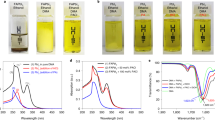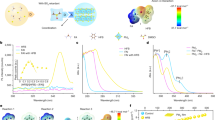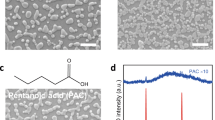Abstract
Controlling the crystallinity and surface morphology of perovskite layers by methods such as solvent engineering1,2 and methylammonium chloride addition3,4,5,6,7 is an effective strategy for achieving high-efficiency perovskite solar cells. In particular, it is essential to deposit α-formamidinium lead iodide (FAPbI3) perovskite thin films with few defects due to their excellent crystallinity and large grain size. Here we report the controlled crystallization of perovskite thin films with the combination of alkylammonium chlorides (RACl) added to FAPbI3. The δ-phase to α-phase transition of FAPbI3 and the crystallization process and surface morphology of the perovskite thin films coated with RACl under various conditions were investigated through in situ grazing-incidence wide-angle X-ray diffraction and scanning electron microscopy. RACl added to the precursor solution was believed to be easily volatilized during coating and annealing owing to dissociation into RA0 and HCl with deprotonation of RA+ induced by RA⋯H+-Cl− binding to PbI2 in FAPbI3. Thus, the type and amount of RACl determined the δ-phase to α-phase transition rate, crystallinity, preferred orientation and surface morphology of the final α-FAPbI3. The resulting perovskite thin layers facilitated the fabrication of perovskite solar cells with a power-conversion efficiency of 26.08% (certified 25.73%) under standard illumination.
This is a preview of subscription content, access via your institution
Access options
Access Nature and 54 other Nature Portfolio journals
Get Nature+, our best-value online-access subscription
$29.99 / 30 days
cancel any time
Subscribe to this journal
Receive 51 print issues and online access
$199.00 per year
only $3.90 per issue
Buy this article
- Purchase on Springer Link
- Instant access to full article PDF
Prices may be subject to local taxes which are calculated during checkout




Similar content being viewed by others
Data availability
The data that support the findings of this study are available from the corresponding authors on reasonable request.
Code availability
The code used for this study is available from the corresponding authors on reasonable request.
References
Jeon, N. J. et al. Solvent engineering for high-performance inorganic–organic hybrid perovskite solar cells. Nat. Mater. 13, 897–903 (2014).
Chao, L. et al. Solvent engineering of the precursor solution toward large-area production of perovskite solar cells. Adv. Mater. 33, 2005410 (2021).
Fei, C. et al. Controlled growth of textured perovskite films towards high performance solar cells. Nano Energy 27, 17–26 (2016).
Yang, M. et al. Perovskite ink with wide processing window for scalable high-efficiency solar cells. Nat. Energy 2, 17038 (2017).
Jeon, N. J. et al. A fluorene-terminated hole-transporting material for highly efficient and stable perovskite solar cells. Nat. Energy 3, 682–689 (2018).
Min, H. et al. Perovskite solar cells with atomically coherent interlayers on SnO2 electrodes. Nature 598, 444–450 (2021).
Kim, M. et al. Methylammonium chloride induces intermediate phase stabilization for efficient perovskite solar cells. Joule 3, 2179–2192 (2019).
Li, P. et al. Phase pure 2D perovskite for high-performance 2D–3D heterostructured perovskite solar cells. Adv. Mater. 30, 1805323 (2018).
Jung, M., Shin, T. J., Seo, J., Kim, G. & Seok, S. I. Structural features and their functions in surfactant-armoured methylammonium lead iodide perovskites for highly efficient and stable solar cells. Energy Environ. Sci. 11, 2188–2197 (2018).
Mahmud, M. A. et al. Origin of efficiency and stability enhancement in high-performing mixed dimensional 2D-3D perovskite solar cells: a review. Adv. Funct. Mater. 32, 2009164 (2022).
Yun, H.-S. et al. Ethanol-based green-solution processing of α-formamidinium lead triiodide perovskite layers. Nat. Energy 7, 828–834 (2022).
Dong, Q. et al. Critical role of organoamines in the irreversible degradation of a metal halide perovskite precursor colloid: mechanism and inhibiting strategy. ACS Energy Lett. 7, 481–489 (2022).
Liang, J. et al. Volatile 2D Ruddlesden-Popper perovskite: a gift for α-formamidinium lead triiodide solar cells. Adv. Funct. Mater. 32, 2207177 (2022).
Zhang, Y. et al. Propylammonium chloride additive for efficient and stable FAPbI3 perovskite solar cells. Adv. Energy Mater. 11, 2102538 (2021).
Park, B.-w et al. Stabilization of formamidinium lead triiodide α-phase with isopropylammonium chloride for perovskite solar cells. Nat. Energy 6, 419–428 (2021).
Min, H. et al. Efficient, stable solar cells by using inherent bandgap of α-phase formamidinium lead iodide. Science 366, 749–753 (2019).
Han, Q. et al. Single crystal formamidinium lead iodide (FAPbI3): insight into the structural, optical, and electrical properties. Adv. Mater. 28, 2253–2258 (2016).
Jeon, N. J. et al. Compositional engineering of perovskite materials for high-performance solar cells. Nature 517, 476–480 (2015).
Huang, Y., Lei, X., He, T., Jiang, Y. & Yuan, M. Recent progress on formamidinium-dominated perovskite photovoltaics. Adv. Energy Mater. 12, 2100690 (2022).
Lu, H. et al. Vapor-assisted deposition of highly efficient, stable black-phase FAPbI3 perovskite solar cells. Science 370, eabb8985 (2020).
Song, S. et al. Molecular engineering of organic spacer cations for efficient and stable formamidinium perovskite solar cell. Adv. Energy Mater. 10, 2001759 (2020).
Zhang, T. et al. Spontaneous low-temperature crystallization of α-FAPbI3 for highly efficient perovskite solar cells. Sci. Bull. 64, 1608–1616 (2019).
Li, G., Zhang, T., Xu, F. & Zhao, Y. A facile deposition of large grain and phase pure α-FAPbI3 for perovskite solar cells via a flash crystallization. Mater. Today Energy 5, 293–298 (2017).
Du, T. et al. Additive-free, low-temperature crystallization of stable α-FAPbI3 perovskite. Adv. Mater. 34, 2107850 (2022).
Zheng, G. et al. Manipulation of facet orientation in hybrid perovskite polycrystalline films by cation cascade. Nat. Commun. 9, 2793 (2018).
Tan, W. L. et al. Oriented attachment as the mechanism for microstructure evolution in chloride-derived hybrid perovskite thin films. ACS Appl. Mater. Interfaces 11, 39930–39939 (2019).
Chen, Z. et al. Room temperature formation of semiconductor grade α-FAPbI3 films for efficient perovskite solar cells. Cell Rep. Phys. Sci. 1, 100205 (2020).
Yadavalli, S. K. et al. Mechanisms of exceptional grain growth and stability in formamidinium lead triiodide thin films for perovskite solar cells. Acta Mater. 193, 10–18 (2020).
Yadavalli, S. K., Zhou, Y. & Padture, N. P. Exceptional grain growth in formamidinium lead iodide perovskite thin films induced by the δ-to-α phase transformation. ACS Energy Lett. 3, 63–64 (2018).
Xie, F. et al. Vertical recrystallization for highly efficient and stable formamidinium-based inverted-structure perovskite solar cells. Energy Environ. Sci. 10, 1942–1949 (2017).
Zhang, H. et al. Influence of Cl incorporation in perovskite precursor on the crystal growth and storage stability of perovskite solar cells. ACS Appl. Mater. Interfaces 11, 6022–6030 (2019).
Lee, J.-W. et al. 2D perovskite stabilized phase-pure formamidinium perovskite solar cells. Nat. Commun. 9, 3021 (2018).
Stone, K. H. et al. Transformation from crystalline precursor to perovskite in PbCl2-derived MAPbI3. Nat. Commun. 9, 3458 (2018).
Wang, X. et al. Perovskite solution aging: what happened and how to inhibit? Chem 6, 1369–1378 (2020).
Zhao, Y. & Zhu, K. Efficient planar perovskite solar cells based on 1.8 eV band gap CH3NH3PbI2Br nanosheets via thermal decomposition. J. Am. Chem. Soc. 136, 12241–12244 (2014).
Stolterfoht, M. et al. Visualization and suppression of interfacial recombination for high-efficiency large-area pin perovskite solar cells. Nat. Energy 3, 847–854 (2018).
Le Corre, V. M. et al. Revealing charge carrier mobility and defect densities in metal halide perovskites via space-charge-limited current measurements. ACS Energy Lett. 6, 1087–1094 (2021).
Duijnstee, E. A. et al. Toward understanding space-charge limited current measurements on metal halide perovskites. ACS Energy Lett. 5, 376–384 (2020).
Min, H., Ji, S.-G. & Seok, S. I. Relaxation of externally strained halide perovskite thin layers with neutral ligands. Joule 6, 2175–2185 (2022).
Acknowledgements
This work was supported by the Basic Science Research Program (NRF-2018R1A3B1052820) through the National Research Foundation of Korea (NRF) funded by the Ministry of Science, ICT and Future Planning (MSIP). H.J.M. and T.J.S. acknowledge the financial support from NRF contract number (NRF-2018R1A5A 1025224). Finally, we thank UCRF (UNIST Central Research Facilities) for support in using the equipment and the beamline staff at Pohang Accelerator Laboratory.
Author information
Authors and Affiliations
Contributions
J.P., J.K. and S.I.S. conceived this work and designed the experiment. H.-S.Y. performed a preliminary experiment. J.P. and J.K. fabricated the PSCs with various electrodes and characterized the perovskite films. M.J.P. and E.N. prepared the electrodes and samples for analysis. H.J.M. and T.J.S. conducted and interpreted the GI-WAXD measurements. M.G.K. measured and interpreted the EXAFS measurements. S.I.S. wrote the draft of the manuscript and all authors contributed feedback and comments for revising the manuscript. S.I.S. directed and supervised the study.
Corresponding authors
Ethics declarations
Competing interests
The authors declare no competing interests.
Peer review
Peer review information
Nature thanks Qilin Dai, Hui Zhang and the other, anonymous, reviewer(s) for their contribution to the peer review of this work.
Additional information
Publisher’s note Springer Nature remains neutral with regard to jurisdictional claims in published maps and institutional affiliations.
Extended data figures and tables
Extended Data Fig. 1 Surface morphologies of thin films.
Thin films spin-coated with 10 mol% MACl (a) and BACl (b) added to FAPbI3 precursor containing 35 mol% MACl. Scale bars, 1 μm.
Extended Data Fig. 2 Changes in the width of the (100)α peak with time.
Shown during annealing from RT to 120 °C, using the thin films formed by dripping the antisolvent during spin-coating of the FAPbI3 precursor solutions containing 0, 5, 10 or 15 mol% PACl added to a 35 mol% MACl.
Extended Data Fig. 3 Representative 2D GI-WAXD images and enlarged 1D GI-WAXD profiles during in situ experiments.
a–e, Control. f–j, Target. k–p, Reference 1. q–u, Reference 2. GI-WAXD measured while increasing and maintaining the temperature from RT to 120 °C. v–y, Enlarged 1D GI-WAXD profiles of control (v), reference 1 (w), target (x) and reference 2 (y) samples around the (100)α peak to investigate the onset temperature of the δ-phase to α-phase transition. z, Plot of the onset temperature of the δ-phase to α-phase transition. 2D GI-WAXD shows that the transition temperature from δ to α phase gradually decreases as the length of the alkyl group in RACl increases from MACl to PACl and BACl. The boiling points and basicity of deprotonated MA0, PA0 and BA0 are different. Thus, strong acid–base interaction can occur between the Lewis acid PbI2 and the Lewis base R-NH2 on the surface of FAPbI3. Alkyl substituents such as methyl, propyl and butyl are electron-donating groups and tend to increase with increasing length. This makes BA0 more Lewis basic, increasing RH2N–PbI2 interaction. Eventually, BA0 deprotonated in BACl lowers more surface energy of δ-FAPbI3, leading to a faster and more effective δ-phase to α-phase transition.
Extended Data Fig. 4 In situ GI-WAXD.
Shown during heating from RT to 120 °C using the thin film deposited without dripping the antisolvent during spin-coating of the FAPbI3 precursor solutions with 10 mol% PACl added to a 35 mol% MACl.
Extended Data Fig. 5 Changes in colour observed at RT of thin films.
Thin films were deposited by dripping the antisolvent during spin-coating of the FAPbI3 precursor solutions containing 10 mol% of MACl, PACl and BACl, respectively, added to a 35 mol% of MACl.
Extended Data Fig. 6 Fourier-transformed RDF.
RDF obtained using theoretically calculated Pb LIII-edge EXAFS for the α-FAPbI3, δ-FAPbI3 and relaxed-FAPbI3, respectively.
Extended Data Fig. 7 Space-charge-limited current analysis.
Shown for reference 1 and reference 2. VTFL is trap-filled limit voltage.
Extended Data Fig. 8 Changes in the mutually normalized integrated area over time and representative 2D GI-WAXD images.
a, Changes in the mutually normalized integrated area obtained by α-phase peaks of in situ GI-WAXD measured while increasing and maintaining the temperature from RT to 120 °C. b, Representative 2D GI-WAXD images of target and reference 2 samples annealed at 120 °C for 30 min.
Supplementary information
Supplementary Information
Supplementary Figs. 1–8 and Supplementary Tables 1 and 2.
Supplementary Video 1
Preparing formamidinium lead triiodide (FAPbI3) black powder by heating at 120 °C in an oil bath with stirring.
Supplementary Video 2
Filtrating the precipitated FAPbI3 using filter paper.
Supplementary Video 3
Depositing perovskite thin films by spin-coating at a relative humidity of 20–30% in ambient air.
Rights and permissions
Springer Nature or its licensor (e.g. a society or other partner) holds exclusive rights to this article under a publishing agreement with the author(s) or other rightsholder(s); author self-archiving of the accepted manuscript version of this article is solely governed by the terms of such publishing agreement and applicable law.
About this article
Cite this article
Park, J., Kim, J., Yun, HS. et al. Controlled growth of perovskite layers with volatile alkylammonium chlorides. Nature 616, 724–730 (2023). https://doi.org/10.1038/s41586-023-05825-y
Received:
Accepted:
Published:
Issue Date:
DOI: https://doi.org/10.1038/s41586-023-05825-y
This article is cited by
-
Toward stabilization of formamidinium lead iodide perovskites by defect control and composition engineering
Nature Communications (2024)
-
Enhancing the efficiency and longevity of inverted perovskite solar cells with antimony-doped tin oxides
Nature Energy (2024)
-
Polymer-acid-metal quasi-ohmic contact for stable perovskite solar cells beyond a 20,000-hour extrapolated lifetime
Nature Communications (2024)
-
A thermotropic liquid crystal enables efficient and stable perovskite solar modules
Nature Energy (2024)
-
Mixed tin-lead perovskites with balanced crystallization and oxidation barrier for all-perovskite tandem solar cells
Nature Communications (2024)
Comments
By submitting a comment you agree to abide by our Terms and Community Guidelines. If you find something abusive or that does not comply with our terms or guidelines please flag it as inappropriate.



